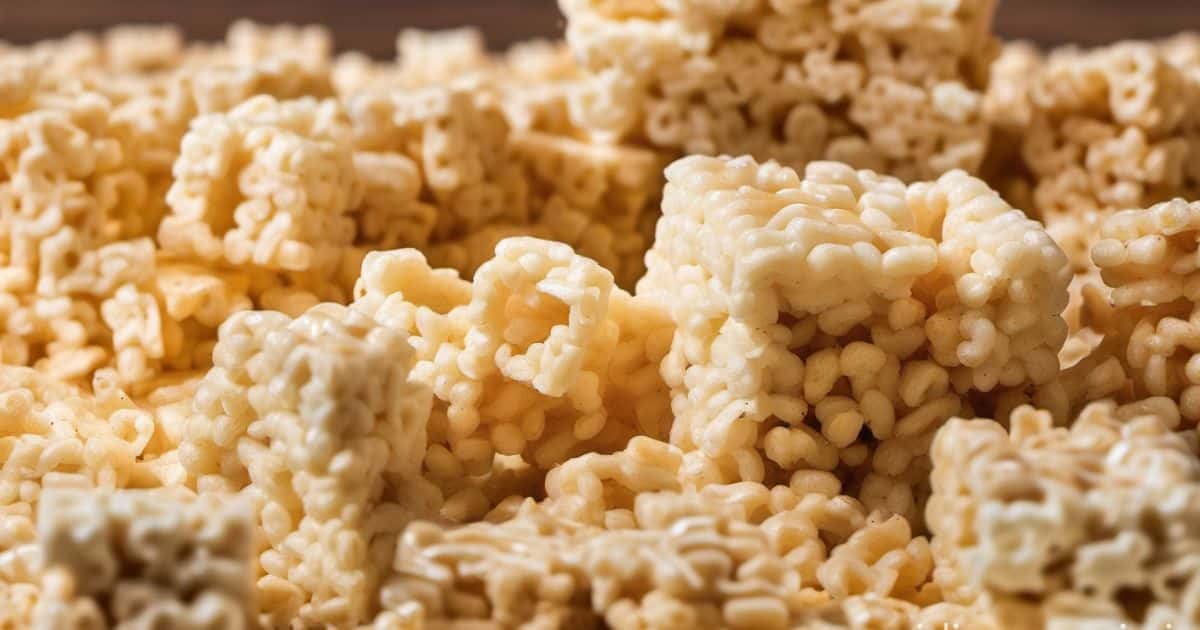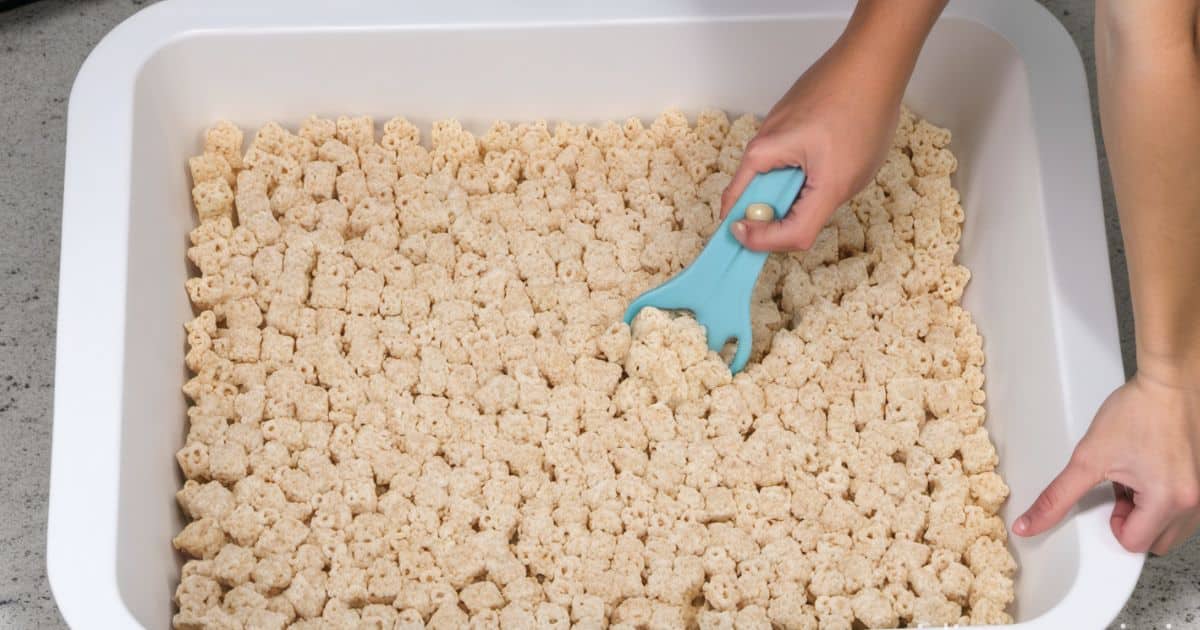Dogs can eat Rice Krispie treats in moderation, but they are not recommended as a regular part of their diet. These treats are high in sugar and offer minimal nutritional value for dogs. They can lead to obesity and dental problems if consumed frequently. Rice Krispies alone, without sugar or marshmallows, are a safer option. Always consult a vet before introducing new foods to your dog’s diet.
Discover the surprising truth about a popular snack: ‘Can Dogs Eat Rice Krispie Treats?’ Uncover whether this sweet treat is a canine delight or a dietary no-no. Read on to learn about feeding your furry friend safely.
What Do You Know About Rice Krispie Treats?
Rice Krispie treats are a classic no-bake snack made by mixing Kellogg’s Rice Krispies cereal with marshmallows and butter, then pressing them into a pan to setup. The cereal gives them their distinctive crispy crunch, while the marshmallows make them sweet and chewy.
Most commercial Rice Krispie treats contain just a few simple ingredients – Rice Krispies cereal, marshmallows, margarine, and vanilla. However, some recipes add extra goodies like chocolate, peanut butter, sprinkles, nuts, and more. So be sure to check the ingredients before sharing any Rice Krispie treats with your pup.
How Are Rice Krispies Made?

Rice Krispies cereal is made by Kellogg’s and consists mainly of rice, sugar, salt, malt flavoring, and iron. To make the famous “snap, crackle, pop” sounds, the rice cereal mix is cooked and then allowed to dry and set. This causes air pockets that pop when milk is added, creating that signature noisy crispness.
So while dogs can generally eat plain rice, the added flavorings and sweeteners in Rice Krispies cereal make it less pet-friendly. The sugar content is a particular concern, as too much can lead to obesity, diabetes, and dental issues in dogs.
What Is The History Of Feeding Rice Krispie Treats To Dogs?
Rice Krispie treats have likely been used as impromptu dog treats for decades. After all, many owners are happy to toss their pooch a little nibble of whatever snack they happen to be enjoying.
However, the idea of customized Rice Krispie treats made specially for dogs is a more recent trend. As more pet owners view their dogs as true family members, the market for specialty dog treats has exploded.
This means you can now find recipes galore for “puppy Rice Krispie treats” made with pet-safe ingredients. You can even buy premade dog treat versions online or in some pet stores.
So while sharing a bite of your snack with your dog here and there seems harmless, regularly feeding dogs conventional Rice Krispie treats may pose risks. But homemade or commercial dog treat versions can make a safer, yummy occasional snack.
Can Dogs Eat Rice Krispie Treats? What Are The Advantages?

At first glance, sharing a nibble of your Rice Krispie treat with your pooch seems like no big deal. So what’s the harm? Well, despite their simple classic ingredients, Rice Krispie treats hide some surprising dangers for dogs. Let’s break down the main risks and downsides piece by piece.
1. Risk of Diabetes
The sugar content poses a risk of obesity, diabetes, and dental decay to dogs prone to weight gain or with difficulty regulating blood sugar levels. Just a small 3 oz Rice Krispie treat contains up to 7 tsp of sugar – far exceeding the recommended daily limits for dogs.
2. Fake Ingredients
While the packaging seems harmless, many commercial Rice Krispie treats actually contain corn syrup, artificial flavors, preservatives, and hydrogenated oils rather than natural ingredients like butter and vanilla. These processed additives offer no nutrition and may cause digestive upset.
3. Choking Risks
The dry, crispy cereal pieces can pose a choking hazard, especially for smaller dogs or aggressive chewers. Inhaling pieces into lungs can cause choking, coughing, gagging, or aspiration pneumonia.
4. Imbalanced Nutrition
Rice Krispie treats are all carbs and sugar, without any redeeming protein, healthy fats, vitamins, minerals. This makes them a “junk food” with empty calories and little nutritional value for dogs.
5. Poisoning From Xylitol
Some recipes sneakily add xylitol or other artificial sweeteners, which are highly toxic for dogs. Unfortunately, the packaging usually won’t list these. So it’s best to avoid sharing any human desserts or sweets to stay safest.
6. Pancreatitis Risk
The high fat content from oils and marshmallows poses a risk of painful pancreatitis inflammation to prone dogs. Greasy, fatty foods are a notorious trigger, so it’s best to stick to low-fat snacks specially formulated for canine digestive systems.
7. Behavioral Reinforcement
Feeding rich human foods reinforces begging behaviors and picky eating habits in dogs. This sets up ongoing challenges at mealtimes or anytime you’re prepping food or snacks.
8. Increased Thirst and Urination
The high sugar quantity acts like a diuretic, causing increased thirst and urination. This can lead to accidents or illness in very young, elderly, or potty-challenged pups.
Are Rice Krispies Good And Safe For Dogs?

Given the laundry list of risks above, it’s clear that Rice Krispie treats – in their classic form – are too risky as dog treats. However, the basic ingredients themselves (rice, marshmallows) may be able to be included safely in moderation as part of balanced homemade dog snacks.
So let’s break down each component individually:
Gluten
Rice itself is generally fine for dogs, including white rice and rice flour. Opt for gluten-free varieties though, as wheat can trigger allergic reactions or tummy troubles. Stick to small portions, as excess rice calories quickly pack on pounds.
Sugar
A little sugar is ok for most healthy dogs, but too much leads to obesity, diabetes, dental decay, and gut issues. Limit added sugar to 5% or less of their daily caloric intake. Natural sweeteners like honey or maple syrup have trace nutrients and may be tolerated better.
Salt
In moderation, salt is generally safe for dogs and adds flavor. But too much can lead to sodium ion poisoning, kidney strain, dehydration, elevated blood pressure, and congestive heart failure. Limit to 100-200 mg sodium per day based on dog’s weight.
High Calories
The high carb & sugar content adds up quick, so Rice Krispie treats must be limited or accounted for in daily calorie limits to prevent obesity. Talk to your vet about appropriate calorie quantities based on your dog’s needs.
Marshmallows in Rice Krispy Treats
Pure marshmallows on their own are gelatin, sugar, and air. In moderation, they’re likely safe for dogs, but may cause loose stools. Homemade marshmallows may use corn syrup or xylitol though, which are toxic. So only use reputable brands of storebought marshmallows to be safest.
The Bottom Line
Taken together, while rice, marshmallows, butter may seem harmless, Rice Krispie treats contain concerning quantities of sugar, carbs, fat, and calories packed into bite-size pieces that seem perfect for tossing to your pup. This makes it far too easy to unintentionally over-indulge your dog with unhealthy empty calories that can negatively impact their health.
7 Great Alternatives to Rice Krispie Treats

Instead of Rice Krispies or marshmallows, choose dog treat alternatives free of excess sugar, salt, fat but packed with natural nutrition! Here are healthier ideas:
1. Dog-Specific Snacks
Choose treats specifically designed for dogs, ideally single-ingredient options like dehydrated chicken or sweet potato chews. Or try limited ingredient biscuits made with identifiable whole foods.
2. Fruits
Fresh, frozen, or dried fruits like blueberries, bananas, mangoes, apples or pineapples make excellent sweet snacks full of fiber and nutrients.
3. Veggies
Dogs love crunching on raw or cooked veggie pieces like carrots, green beans, cucumbers, pumpkins or squash.
H3: 4. Freeze-Dried Meats
Dehydrated 100% meat treats like single-ingredient freeze-dried chicken, beef liver, or turkey hearts offer pure protein power.
5. Home-Made Dog Treats
Whip up custom crunchy biscuits or chewy goodies using pet-safe ingredients and recipes formulated specifically for dogs.
6. Dental Chews
Naturally abrasive treats like vet-approved raw hides, antlers, hooves, and compressed rawhide bones clean teeth while satisfying chewing urges.
7. Chewing Bones
From classic rawhide bones to natural bones or even frozen carrots or bananas, find a safe chew toy suited to your dog’s size and chewing style.
Instructions For Making A Rice Krispie Treat At Home For Your Dog

Want to capture that classic Rice Krispie taste in a homemade doggie version? Here’s a simple recipe:
Ingredients
- 3 cups Rice Krispies
- 1⁄4 cup peanut butter (xylitol-free)
- 1 tsp maple syrup
- Optional add-ins: 1⁄4 cup diced apples, bananas, blueberries
2 tbsp shredded coconut
Instructions
- In microwave-safe bowl, melt peanut butter and maple syrup, about 30 seconds
- Pour over Rice Krispies in large bowl
- Gently fold mixture until fully coated
- Mix in any optional add-ins if desired
- Pour into greased baking pan (8×8 size)
- Lightly flatten and shape
- Refrigerate 1 hour until firm
- Cut into bite-size squares
- Store airtight container up to 1 week
Homemade Rice Krispy Recipes for Your Dog
Get creative with pet-friendly Rice Krispy recipes like:
- Chocolate Chip Rice Bone Treats
- Spooky Ghost Marshmallow Pups
- Pumpkin Pie Pupsicles
- Birthday Cake Doggie Delights
Follow dog treat cookbooks or websites for step-by-step recipes using dog-safe ingredients like whole grain flours, real fruits and veggies, Greek yogurt, peanut butter, honey, and more. Then customize with your pup’s name, fun seasonal shapes, or mix-ins suited to their dietary needs or preferences!
Can Dogs Eat Rice Krispie Treats With Marshmallows
“Plain marshmallows themselves contain nothing inherently toxic to dogs. However, their spongy texture poses a potential choking risk for aggressive chewers. The main concerns of marshmallows, especially when considering if Dogs Eat Rice Krispie Treats, revolve around what other ingredients get added during processing or recipes.
- Sugar – Marshmallows have a high sugar content, which can lead to obesity, diabetes, dental decay, gastrointestinal and hormonal issues if overfed. Limit sweets to less than 10% of daily calories.
- Xylitol – Some sugar-free marshmallow brands replace sugar with xylitol, an artificial sweetener extremely toxic to dogs. Unfortunately, food labels won’t always specify this. So only use major national name-brand marshmallows to reduce this risk.
- Corn syrup – Homemade marshmallow recipes often rely on corn syrup for smooth texture. While not toxic to dogs, high fructose corn syrup has no health benefits and too much may cause digestive upset or weight gain.
- Ingredients in Recipes – Rice Krispie treats get their added flavors from ingredients like chocolate, peanut butter, caramel, nuts, etc which may also be dangerous if they contain xylitol or macadamia nuts. Always vet all ingredients in any homemade recipe.
- Portion control is also crucial with any marshmallow-based treats. The combination of sugar, fat, carbs and calories adds up extremely quickly. So treats like Rice Krispie treats with marshmallows should only be occasional snacks. Opt for healthy alternatives like fruits and veggies for daily treats instead whenever possible.
Frequently Asked Questions (FAQs)
What are some safe cereal food options for dogs?
Safe cereal options for dogs include plain, cooked rice, oatmeal, and wheat-based cereals without added sugar or flavorings. These should be served in moderation as part of a balanced diet.
What cereals should be avoided entirely for dogs?
Avoid cereals containing chocolate, xylitol, excessive sugar, artificial sweeteners, or caffeine. Also, cereals with high-fat content or artificial additives should be avoided for dogs.
What are some undesirable effects on dogs after too much Rice Krispy consumption?
Excessive consumption of Rice Krispies can lead to obesity, dental issues, digestive disturbances, and potentially contribute to diabetes. The high sugar and low nutritional value make them unsuitable as a regular dog treat.
Can I use marshmallows for Rice Krispies for dogs?
It’s best to avoid marshmallows in Rice Krispies for dogs. Marshmallows are high in sugar and may contain xylitol, which is toxic to dogs. They offer no nutritional benefits and can be harmful.
How long is Rice Krispies good for?
Rice Krispies, when stored properly in a cool, dry place, can last for 6-12 months. However, once made into treats with marshmallows, they should be consumed within a few days and are not recommended for dogs.
Are Rice Krispy treats safe for dogs to consume?
Rice Krispy treats are not recommended for dogs due to their high sugar content, potential choking hazard, and lack of nutritional value. Dogs are better off with treats made specifically for their dietary needs.
What are some healthy alternatives to Rice Krispies for dogs?
Healthy alternatives include dog-specific treats, fruits like apples or bananas (in moderation), vegetables like carrots or green beans, and lean meats. Always choose treats suitable for your dog’s dietary needs.
Can Dogs Eat Cheerios? The Amazing Truth Revealed!
Plain Cheerios can be a low-calorie, low-fat treat for dogs in moderation. However, they should not replace regular, nutritionally balanced dog food and treats.
Can Dogs Eat Guava? The Secret Fruit That Will Shock You!
Yes, dogs can eat guava in moderation. It’s a vitamin-rich fruit that can be a healthy snack for dogs. However, it should be introduced slowly to ensure it doesn’t cause digestive upset.
Finally
In conclusion, while dogs can technically eat Rice Krispie treats, they are not the ideal choice for canine snacks. The high sugar content and lack of nutritional value in these treats can lead to health issues like obesity, diabetes, and dental problems. Additionally, ingredients like marshmallows and added flavors may pose risks such as choking hazards and toxicity. Alternatives like dog-specific snacks, fruits, vegetables, and homemade treats tailored for dogs are healthier options. Ultimately, moderation is key, and consulting with a veterinarian before introducing new foods to your dog’s diet is always advised. Remember, what seems like a harmless treat to humans can have different implications for our furry friends. Learn more about Dogs Eat information “Can Dogs Eat Tamales? Are They Good or Bad for Your Dog?“









